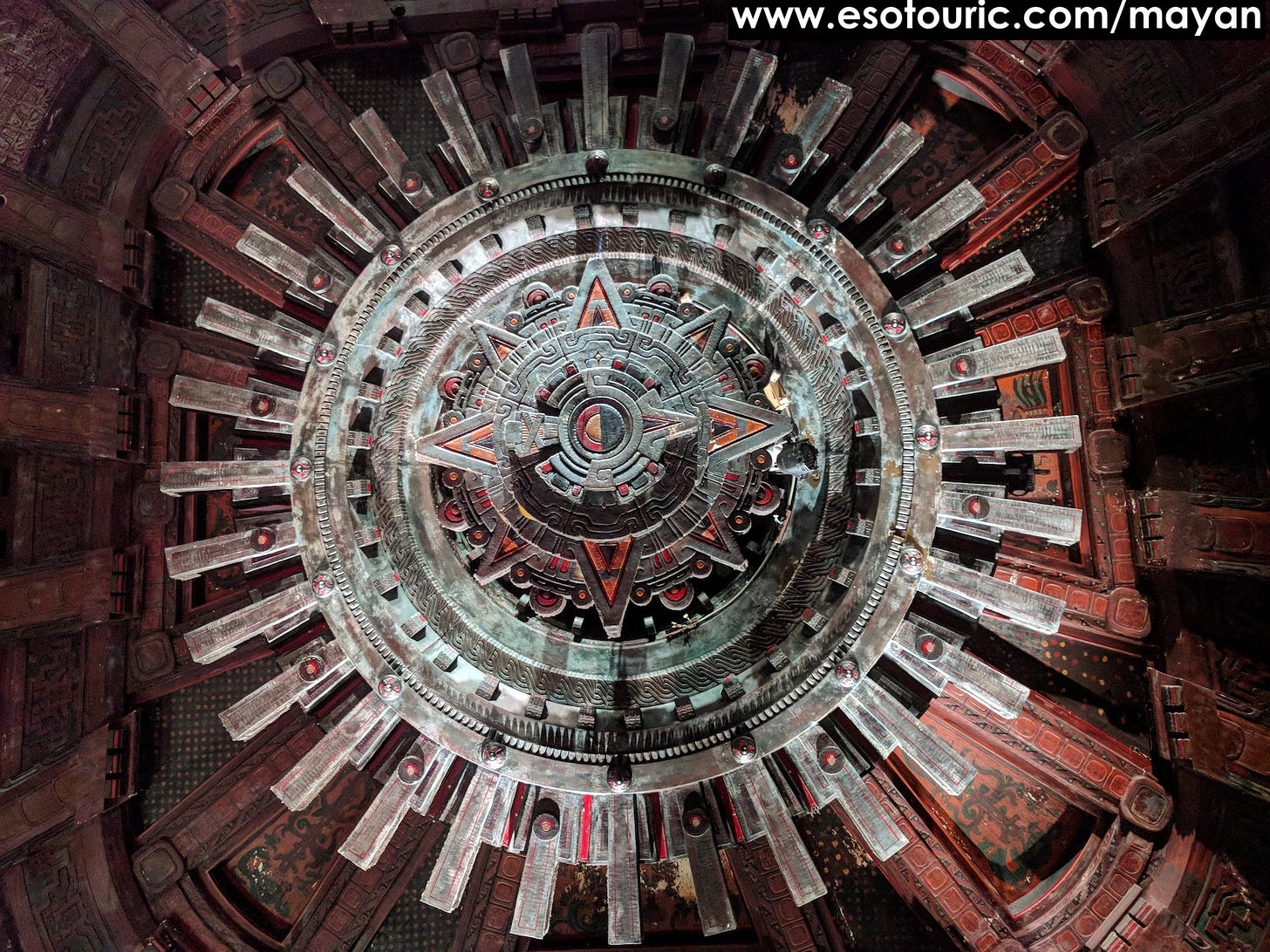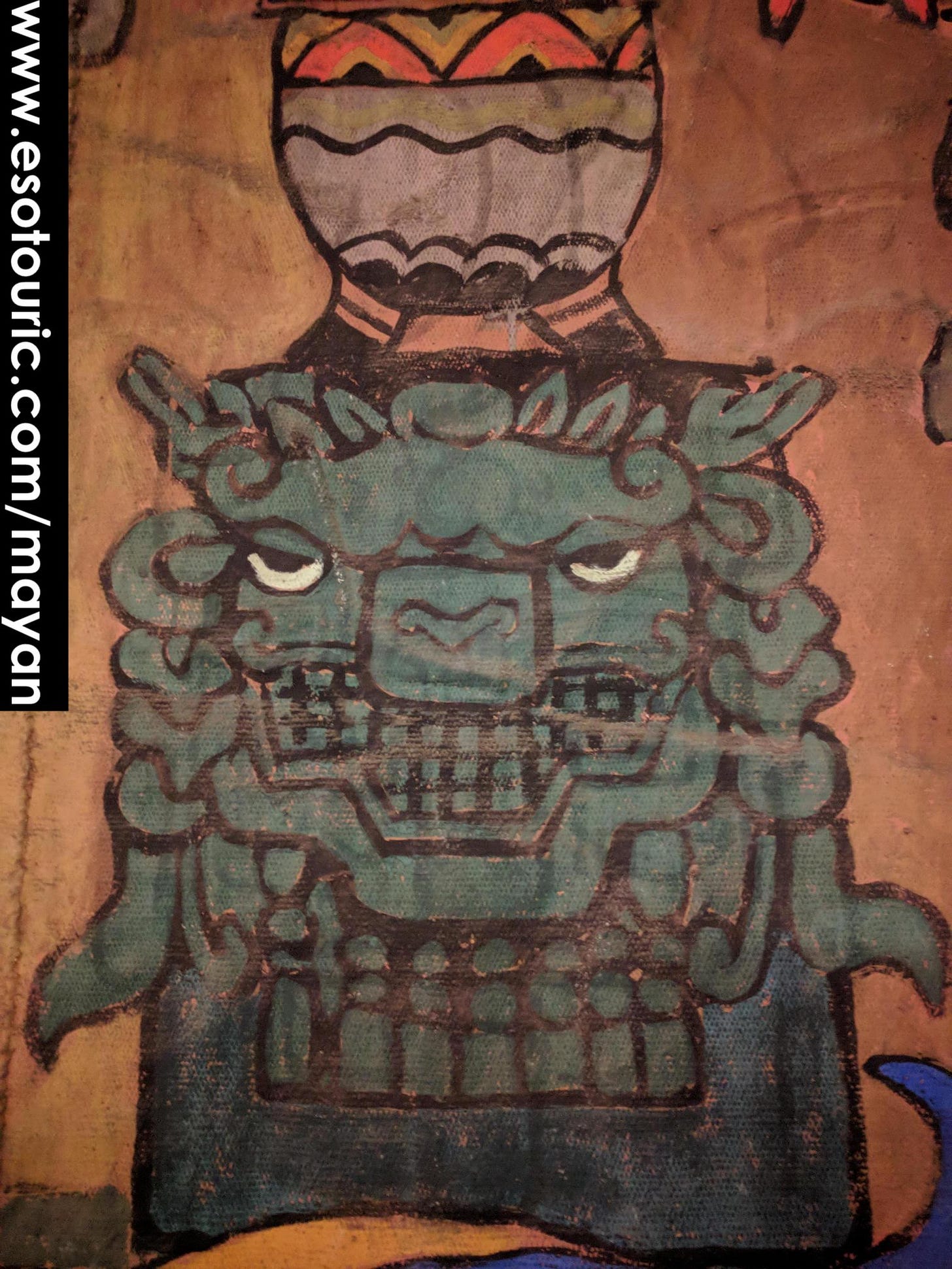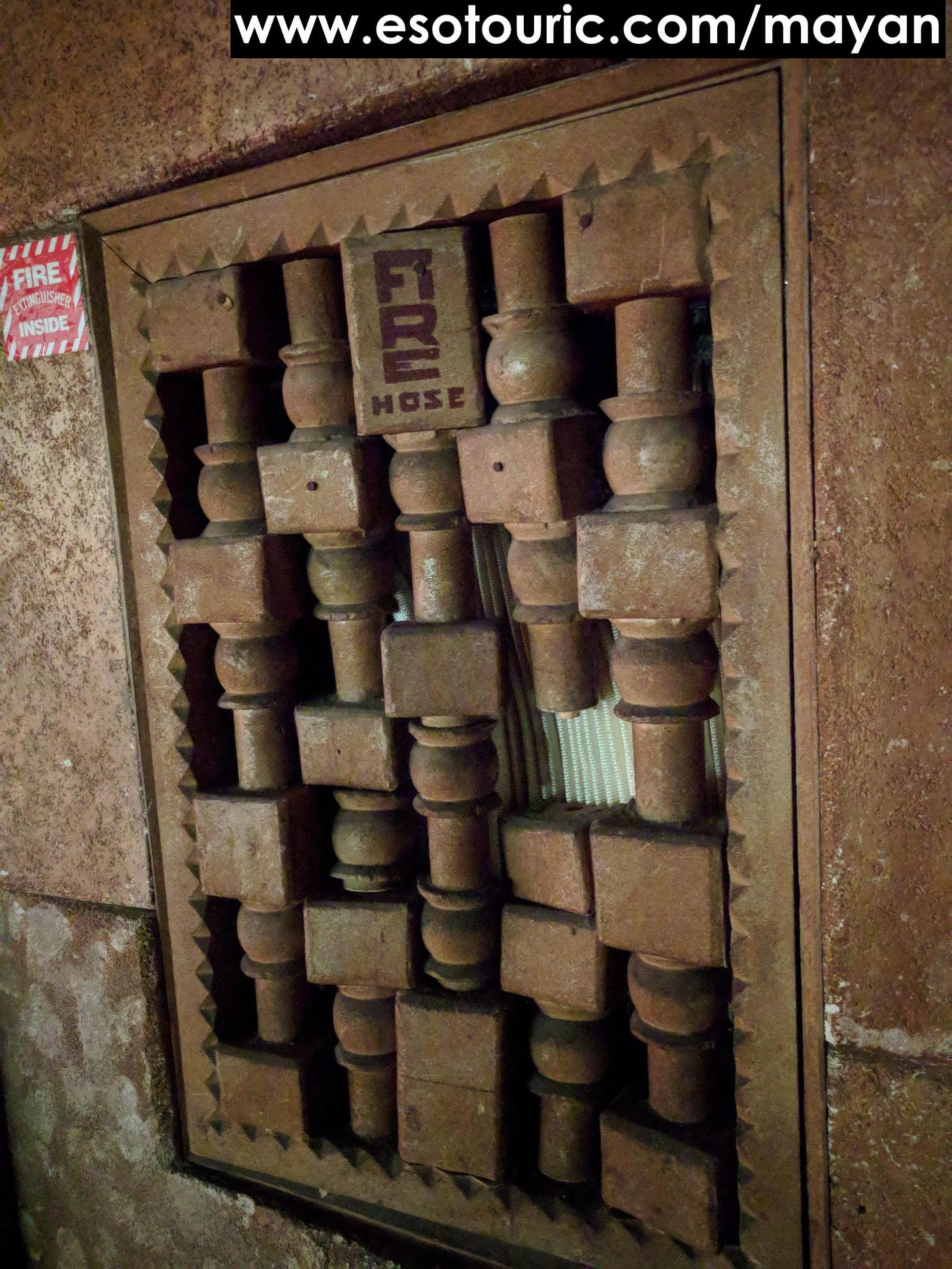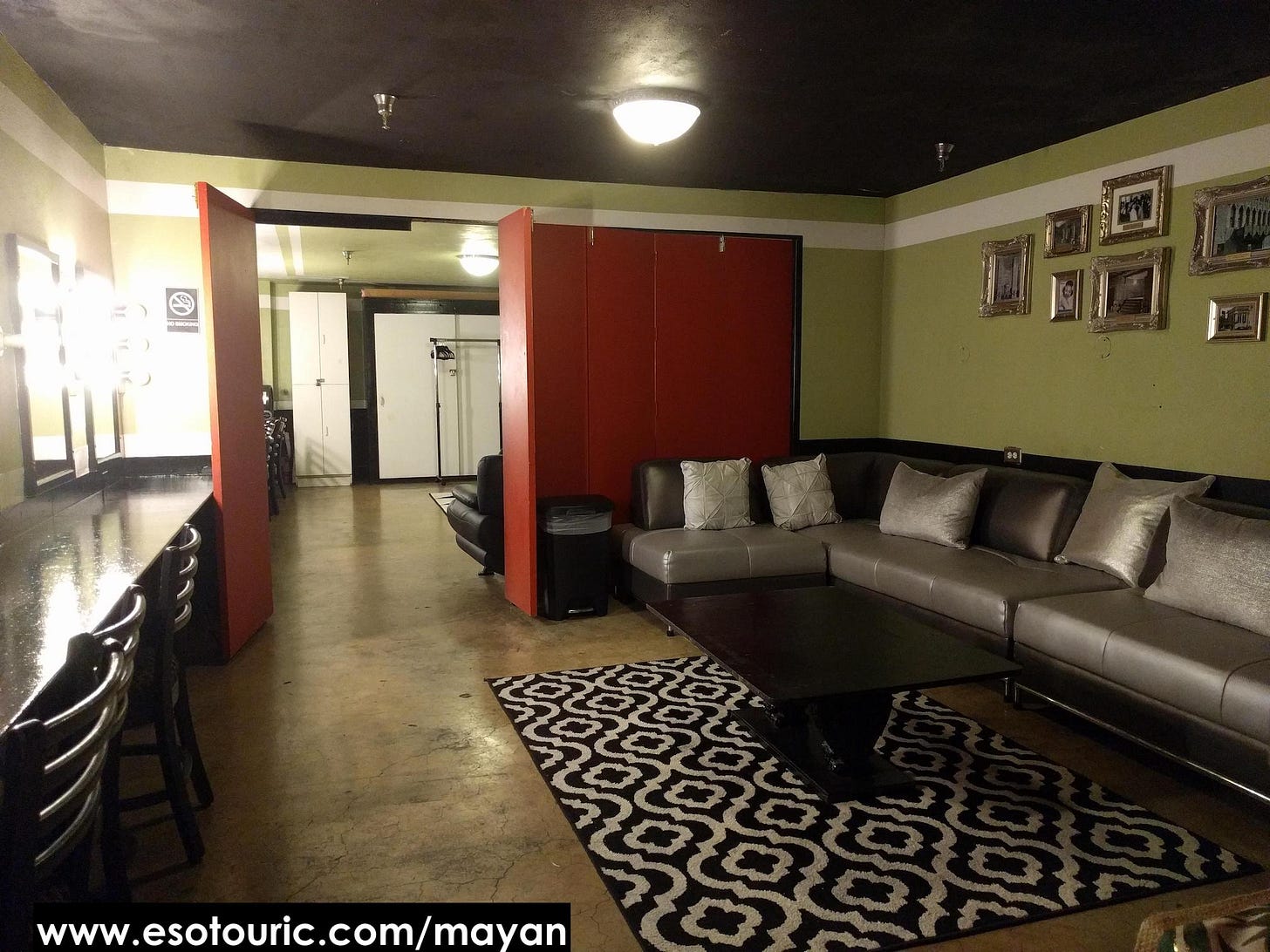Re-post: Archeological Explorations in Downtown's Mayan Theatre
The exotic architecture is spectacular, but it's some pencil stub scribblings on a plain cement wall that really blew our mind
Update July 14, 2025: We are bringing this 2020 subscriber edition of our L.A. cultural history and preservation newsletter out from behind the paywall on the occasion of the extremely sad announcement that the Chao family will be closing the Mayan Theatre nightclub on September 13.
Scroll down to where it says ORIGINAL 2020 NEWSLETTER FOLLOWS to learn about the fascinating things that we documented on a front and backstage tour a few years back. And read on for our thoughts on what Angelenos need to do to if we’re to save precious places like the Mayan.
As we told SF Gate last December, the Mayan is an unlikely architectural and cultural landmark that was preserved by its association with the pornographic film industry. The white elephant on the outskirts of Broadway’s still hopping motion picture row was purchased by porn director Carlos Tobalina in 1969, converted to L.A.’s fanciest stroke house, then leased by Tobalina’s family to the Chaos for a successful and respectful nightclub conversion. It turns 35 this year.
The Mayan’s survival as a venue speaks to the evolution of a century of Southern California entrepreneurship and the undeniable fact that people love cool old buildings and will make them a destination if given the opportunity. You can dance (or watch naked people on screen) anywhere, but only in the Mayan can you do that surrounded by ancient jungle gods!
As the darkest economic shadows we have ever known gather around Downtown Los Angeles, and beloved and iconic legacy businesses flicker out like stars dying in every quadrant of the sky, we have a message for Angelenos who care and want it to stop:
It was our so-called leaders who got us into this mess—former mayor Eric Garcetti and confessed racketeer councilman Jose Huizar—by putting fat thumbs on the scales to benefit overseas developers of new towers, and doing nothing to protect existing landmarks and the independent businesses that keep them alive while activating our commercial corridors and employing Angelenos.
The tools exist to create a safety net to protect and preserve our cultural landmarks. Smaller towns have done it, and Los Angeles can do it, too.
Reviving Downtown as a creative economic engine, and leveraging the passion that locals and visitors feel for our landmarks is a no brainer, but City Hall is never going to come up with such a smart idea on its own. Instead, it throws billions into failed housing policies, and leaves cultural incubator programs that could help keep people employed and housed, while preserving our landmarks, as half formed shells, unfunded and abandoned.
One thing we’ve learned as historians of 1930s noir Los Angeles, and chroniclers of the neo-noir wave of political land use corruption that is presently strangling the city: history rhymes like a poet wired on triple espressos. The Jack Lemmon scene from Save the Tiger that so beautifully captures Carlos Tobalina’s XXX era at the Mayan is about a Downtown L.A. businessman at the end of his financial rope, sealing a deal with a philosophical arsonist to make his inconvenient building go away.
We all wonder about the fires that keep breaking out in nice old buildings that are held vacant by speculators who don’t develop anything, and don’t let anyone rent them, either.
As the star that is the Mayan nighclub begins to flicker out, we’re calling on Angelenos to take back our derelict commercial districts, reactivate the unleased commercial and performance spaces, and begin the revival we’ve all been waiting for.
It is time to demand that elected officials address the rampant vacancy crisis that has turned Downtown and Hollywood into dead zones, and artificially inflated the cost to rent even the crummiest, tiniest apartment. Demand they use the carrots and sticks of public policy to get empty spaces back on the market, to shut down illegal Airbnbs, to give us back the great city we all see rotting on the vine.
Angry emails set to inboxes that are ignored won’t do it. Nor will making public comment to spaced out officials fiddling with their phones. Angelenos who know how to get stuff done need to start holding their own public hearings, announcing effective policy paths, building alliances and rebuilding the networks that keep a great city alive, and letting the politicians know that they can either come along on a path blazed by Angelenos, or get left behind.
For more of our musings on the threat facing Los Angeles legacy businesses that occupy historic landmarks, and City Hall’s unwillingness to help, tune in to this interview we gave Michael Monks of KFI on Saturday about the pending closure of Cole’s. Our section starts about 15:30 into the episode.
Farewell, dear Mayan nightclub. The City of Angels thanks you, Sammy and Susan Chao, for being such caring stewards. We know how hard you’ve worked, and how much you love the place. Through rough seas and gentle ones, you’ve kept a true treasure of old Los Angeles alive and brought so much joy.
Our sincere hope is that another operator will be able to pick up where you left off very soon, and that you’ll enjoy a much deserved retirement from the toughest, most rewarding business of all: making a place where people can come together, enjoy something beautiful and historic and have a ball.
Yours for Los Angeles,
Kim & Richard
Esotouric
Are you on social media? We’re on Instagram, Twitter, Facebook, YouTube, Mastodon, Threads, Bluesky, Substack Notes, TikTok and Reddit sharing preservation news as it happens. New: we’re on Nextdoor now, too.
Our work—leading tours and historic preservation and cultural landmark advocacy—is about building a bridge between Los Angeles' past and its future, and not allowing the corrupt, greedy, inept and misguided players who hold present power to destroy the city's soul and body. If you’d like to support our efforts to be the voice of places worth preserving, we have a tip jar, vintage Los Angeles webinars available to stream, in-person tours and a souvenir shop you can browse in. We’ve also got recommended reading bookshelves on Amazon and the Bookshop indie bookstore site. And did you know we offer private versions of our walking tours for groups big or small? Or just share this link with other people who care.
UPCOMING WALKING TOURS
• The Real Black Dahlia (7/19) • Early Hollywood’s Silent Comedy Legends (7/26) • Hotel Horrors & Main Street Vice (8/9) • Weird West Adams / Elmer McCurdy Museum (8/16) • Christine Sterling & Leo Politi: Angels of Los Angeles (8/23) • Evergreen Cemetery, 1877 (8/30) • Raymond Chandler’s Noir Downtown Los Angeles (9/6) • Film Noir / Real Noir (9/20) • Angelino Heights & Carroll Avenue (9/27)
ORIGINAL 2020 NEWSLETTER FOLLOWS -
Gentle reader,
We’re grateful that you’ve signed up to receive this special subscriber’s edition of the Esotouric newsletter, launched to provide us with some income while our tour business is shuttered during the pandemic. Thank you for believing in us!
For our latest post that’s hidden from the rest of the internet, we’d like to take you into the hidden recesses of the most exuberant of the historic theaters in Downtown Los Angeles, The Mayan (architects Morgan, Walls and Clements, with iconography by Francisco Cornejo adapted from archeological sources, 1927).
Pre-COVID, the Mayan operated as a nightclub, with mood lighting that made it difficult for visitors to fully appreciate its complicated symbolic scheme and the rich colors of its decorative tile, wall paintings and painted stage curtain.
But two summers ago, while we were scouting locations for Richard’s 50th birthday tour in association with the Huntington’s exhibition Architects of a Golden Age, the owners welcomed us inside for a rare daylight tour. Ultimately, scheduling conflicts didn’t allow the tour group to explore the theater’s interior, but they admired the façade as part of a breakneck day’s exploring.
This summer, we’re mostly staying inside with the cats, and not out scouting cool landmarks for Richard’s 2020 birthday tour, which has us feeling a little blue. So we dug back into our photo archives to explore the Mayan Theatre again.
The Mayan has the distinction of having enjoyed four very distinct mass entertainment uses. It opened on August 15, 1927 as a legitimate theater hosting touring East Coast musicals, then in 1929 exhibited its first motion picture. In 1969, the auditorium was subdivided to screen XXX pictures, a seedy period memorably captured in the 1973 Jack Lemmon film Save The Tiger and this 1986 photograph by Ned Paynter. Home video killed the market. It became a nightclub in 1990.
A history of the Mayan’s varied programming through newspaper advertising can be found on the Los Angeles Theatres blog.
Come inside and see just how the language of ancient Central American architecture and culture was spun out like psychedelic cotton candy for the theater going audiences of Jazz Age Los Angeles.
The ZigZag Moderne neon blade sign perches above glyphs and faces thick with many decades of amateur painted touch ups. The original façade treatment would have been more refined.
In the wide, shallow lobby, every surface is alive with stylized gods and serpents. The stair rails are stunning.
A silent feathered warrior dares you to break his stare.
Guardian figures based on the Tikal stelae replicas at Museum of Man in San Diego flank the surprisingly narrow stage. The brownish red tones of the auditorium are meant to evoke the incorruptible Chico Zapote wood favored by Mayan temple builders.
On the ceiling, a Mayan calendar wheel marks the 260 named days of that culture’s ritual year.
The painted asbestos curtain is a dense jungle scene with costumed figures clustered at the front of the stage, performing a ritual. Above them, brightly colored birds, leaves and flowers frame a distant temple complex.
Even the fire hose box has an original decorative scheme suggesting stacked temple blocks. How we longed to straighten them!
Back in the lobby, feathered serpents with lolling tongues beckon holders of cheap tickets up to the balcony.
That’s the front of the house, and it’s spectacular. If you’d like to know more about the ancient sources for Francisco Cornejo’s designs, see his thorough article in Pacific Coast Architect.
But every theater is also a functional space, and it’s often the utilitarian backstages that are most revealing.
Some electrical boxes are still in use, others are relics with crackle glaze patina.
The Chicago Pump Co. (since 1909) keeps the basement dry.
The Mayan has a modern performers’ lounge, with bright mirrors for last minute primping.
The attached single stall restroom still boasts its 1920s green porcelain fixtures, cool as morning mist off a jungle pyramid.
You’ve scrolled down all this way, so here’s your reward in the form of an archeological discovery.
In a small room off the backstage hall, a glaring reflection comes from a sheet of plexiglass that’s screwed to the concrete wall. It protects pencilled notations that list the theater’s earliest productions, who starred and how long the show ran.
Taken from the top, we read:
GRAND OPENING
AUG. 15, 1927
O-KAY | ELSIE JANIS | 8 WEEKS | MUSICAL | AUG. 15, 1927
TWINKLE TWINKLE | JOE E. BROWN NANCY WELFORD | 6 WEEKS | MUSICAL | OCT. 10, 1927
SUNNY | HARRY MILLER HELEN PATTERSON | 10 WEEKS | MUSICAL | NOV. 27, 1927
CONNECTICUT YANKEE | MAURICE KUSSELL | 2 WEEKS | MUSICAL
CAPTIVE | ANNE DAVIS OWEN MOORE | 4 PERFS. | DRAMA
INTERFERENCE | PAT SOMERSET | 2 WEEKS | DRAMA
and on down the long wall to number 15, MARIANNE, a “talking picture” starring Marion Davies, debuting September 5, 1929—with a noted statesman in attendance—and running for five weeks.
After Marion’s big night, the Mayan reverts back to stage shows, with an occasional light opera, public lecture and one-night holiday spectacular well into the 1930s. And with each opening and closing night, an anonymous Angeleno (possibly manager Edward Belasco) recorded the particulars in a blocky pencil stub scrawl.
It’s not Egyptian hieroglyphics or Mayan glyphs, nothing so ancient as that. But to place one’s finger atop the protective plexiglass sheet and trace the letters below sparks a powerful connection to our young city’s creative past, when the hottest touring Broadway shows could be found on Hill Street, just steps off our own Broadway.
Local lore holds that when the Mayan became a straight and gay porn venue in 1969, management didn’t just show X-rated movies in the auditorium, but also shot original skin flicks in the basement.
We can’t help but imagine a bored, gum-smacking ingenue waiting for her call, wandering into the room where the theater’s history was inscribed and scrolling down the list of names that once glowed in lights. Did they seem as obscure to her as the ancient jungle civilizations do to us today?
And stuck at home with the cats, as performance venues nationwide sit dark and struggle to survive our shared troubles, we’re thinking of the Mayan’s four past lives, and praying it’s got five more in the bag.
You can help by supporting the Save Our Stages campaign, advocating for a bail out for the once lively and oft historic venues we can’t afford to lose.
And if you’d like to see the Mayan Theatre for yourself, just the façade is worth a detour. You’ll find it at 1040 South Hill Street, next to the Belasco Theatre and a block from the White Log Coffee Shop.
yours for Los Angeles,
Kim & Richard
Esotouric



























.amazing article with very cool pictures and story telling. Keep up the good work which I appreciate with all my heart
Babs